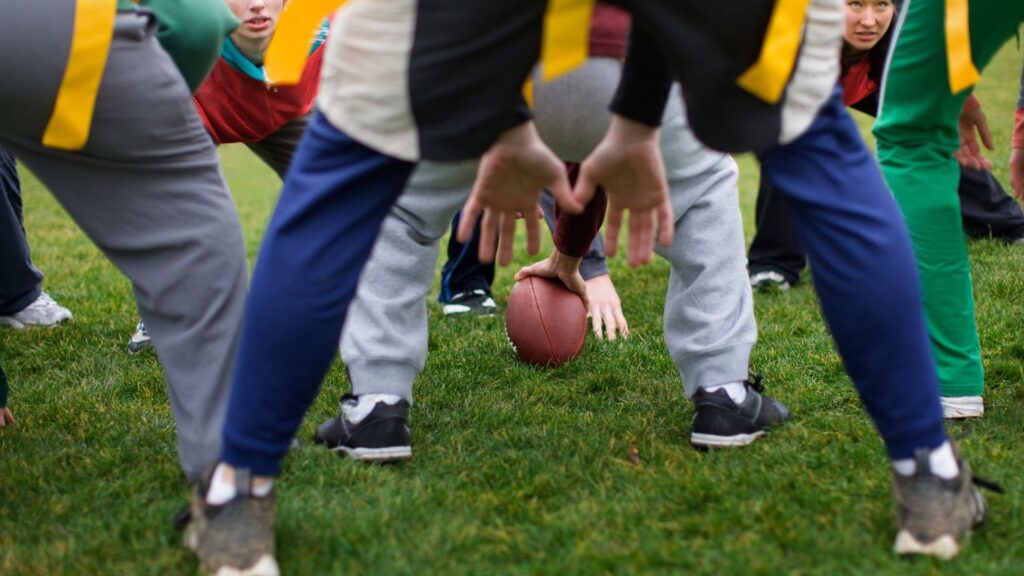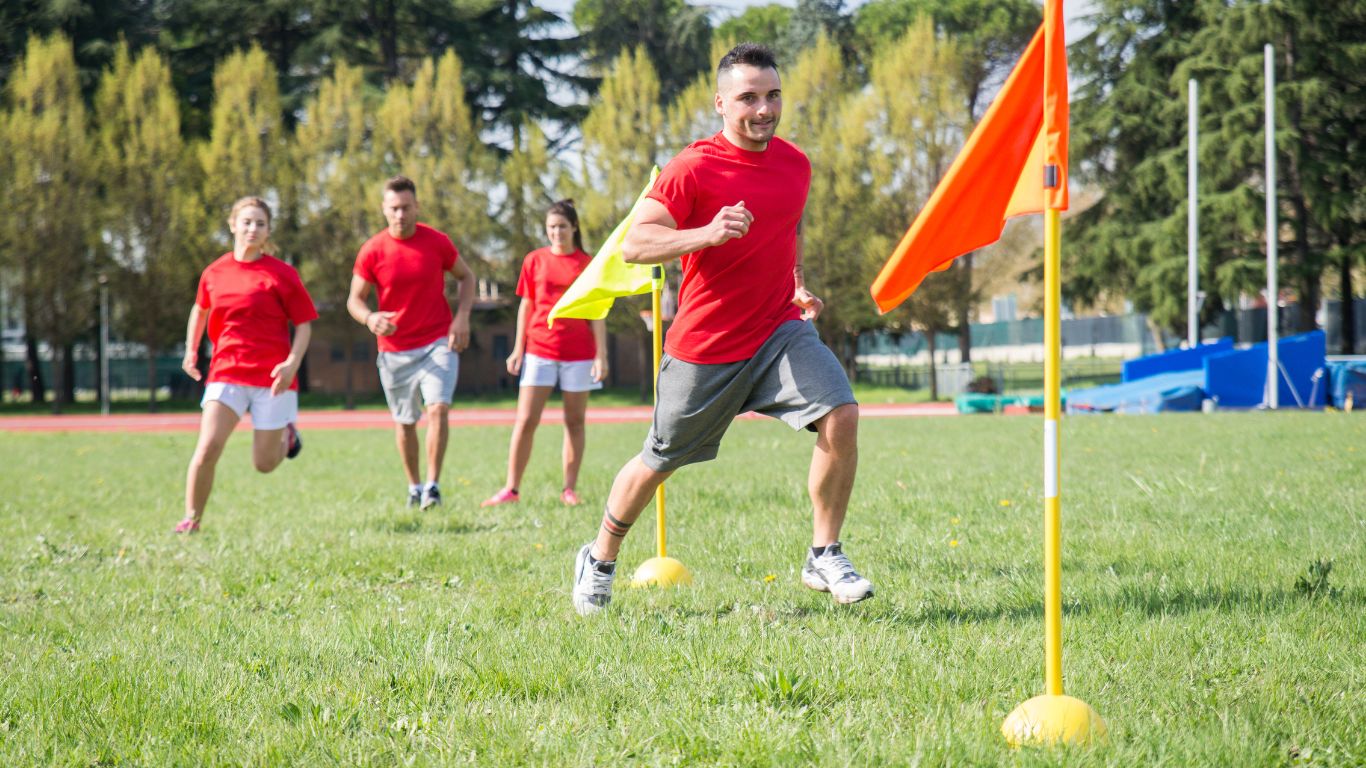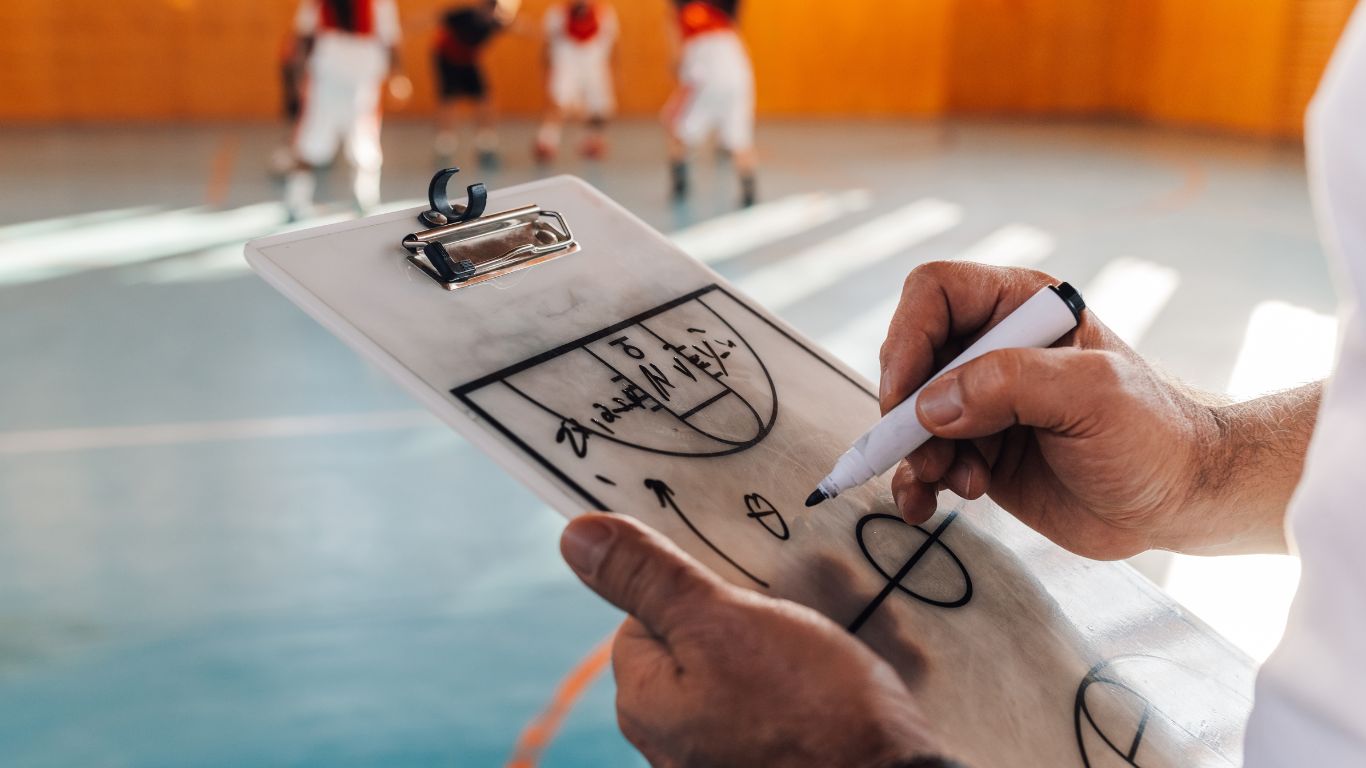Flag football is a popular and exciting alternative to traditional tackle football. It offers all the thrills of the game without the physicality and risk of injury that comes with tackling. Whether you’re a seasoned athlete or a newbie to the sport, flag football is a great way to stay active, have fun, and sharpen your skills on the field.

We’ll guide you through the basic rules and strategies of flag football to help you get started. We’ll cover everything from how to set up the field and divide teams to essential offensive and defensive strategies to enable you to dominate the game. So grab your flags and get ready to hit the field – the game of flag football awaits!
Basic rules of flag football
Flag football is a fun and exciting alternative to traditional tackle football, perfect for players of all ages and skill levels. Suppose you’re new to the game or just looking for a refresher. In that case, it’s essential to understand the basic rules of flag football to ensure a fair and enjoyable experience for everyone involved.
One of the fundamental rules of flag football is that instead of tackling opponents to the ground, players must instead remove their opponents’ flags to stop the play. Each player wears a belt with two flags attached, which are connected to each hip. When a player with the ball has their flag pulled by an opposing player, the play is considered over.
Flag football is typically played with two teams of five to seven players each, with a designated quarterback who is responsible for leading the team’s offense. The quarterback lines up behind the center, who snaps the ball to start the play. The quarterback can pass the ball to their teammates, hand it off to a running back, or even run with the ball themselves – as long as they are able to avoid having their flag pulled by the defense.
On offense, players have four attempts, or downs, to advance the ball at least 20 yards down the field and score a touchdown. A touchdown in flag football is worth six points, and the scoring team then has the option to try for an extra point by attempting to pass or run the ball into the end zone from a short distance away.
Defensively, the goal is to prevent the offense from scoring by pulling their flags and stopping their progress down the field. Defensive players are not allowed to physically contact the ball carrier or obstruct their movement in any way – they must rely solely on pulling the player’s flags to make a stop.
One of the most essential rules in flag football is the “no contact” rule, which means that players are not allowed to grab, push, or otherwise physically interfere with their opponents during the game. Any contact that is deemed unnecessary or overly aggressive can result in penalties assessed against the offending team, which can lead to yardage deductions, loss of downs, or even ejection from the game.
Another critical rule in flag football is the use of the “one-second rush” count, which requires the defense to wait one second after the ball is snapped before attempting to rush the quarterback. This rule helps to give the quarterback time to set up and make a play while also providing the offense a fair chance to execute their plays without being rushed or pressured.
Overall, flag football is a fast-paced and exciting game that offers all the thrills of traditional football without the physical contact and risk of injury. By understanding and following the basic rules of flag football, you can enjoy a fun and competitive game that is safe and enjoyable for players of all ages and skill levels. So grab your flags, gather your friends, and hit the field for a game of flag football today!
Skills needed to excel in flag football
Flag football is a fun and fast-paced sport that people of all ages and skill levels can play. While it may not require the same level of physicality as traditional tackle football, it does need a particular set of skills in order to excel on the field.
One of the most essential skills in flag football is speed. Being able to move up and down the field quickly can give you a significant advantage over your opponents. Whether you are running with the ball or chasing down the person who has it, having good speed can help you make big plays and score touchdowns.
In addition to speed, agility is also a crucial skill in flag football. Being able to change direction quickly, juke past defenders, and make sharp cuts can help you avoid getting your flag pulled and keep the defense on their toes. Having good agility can also assist you in making quick, evasive moves that can lead to significant gains on offense.
Hand-eye coordination is another critical skill in flag football. Being able to catch passes, snag flags, and make accurate throws can make a huge difference in your performance on the field. Practicing catching and throwing drills can help improve your hand-eye coordination and make you a more effective player.
Communication is also essential in flag football. Communicating effectively with your teammates helps you work together as a cohesive unit and execute plays more efficiently. Whether it’s calling out plays, directing teammates on defense, or providing encouragement and support, good communication can help your team succeed.
Another crucial skill in flag football is awareness. Being aware of your surroundings, knowing where the ball is at all times, and being able to anticipate the movements of your opponents can give you a strategic advantage on the field. Keeping your head on a swivel, staying focused, and paying attention to the game can help you make intelligent decisions and react quickly to changing situations.
Lastly, having good decision-making skills is essential in flag football. Knowing when to pass or run, when to go for the flag or tackle, and when to take risks or play it safe can make a massive difference in the outcome of the game. Being able to think quickly on your feet, analyze the situation, and make wise choices can help you lead your team to victory.
Excelling in flag football requires a combination of physical skills, mental sharpness, and teamwork. By working on your speed, agility, hand-eye coordination, communication, awareness, and decision-making skills, you can become a more effective and successful player on the field. Remember to practice regularly, stay focused, and always give it your all, and you’ll be well on your way to becoming a flag football standout.
Strategies for offense and defense
Flag football is a fun and exciting sport that combines the elements of football with the added challenge of pulling a player’s flag to simulate a tackle. In order to be successful in flag football, it is essential to develop effective strategies for both offense and defense.
When it comes to offense, one key strategy is to mix up your plays in order to keep the defense guessing. By running a variety of different plays, such as short passes, long bombs, and running plays, you can save the defense on their toes and make it harder for them to anticipate your next move.
Another important offensive strategy is to have good communication with your teammates. By working together and communicating effectively, you can coordinate your movements and make it easier to execute plays successfully. Make sure to establish hand signals or verbal cues so that everyone on the team is on the same page.
In addition, it is essential to be aware of the field’s dimensions and use them to your advantage. By spreading out the field and utilizing both the width and depth of the playing area, you can create mismatches against the defense and find open spaces to exploit.
On the defensive side of the ball, one key strategy is to focus on pulling the opposing player’s flags quickly and efficiently. By practicing your flag-pulling techniques and working on your agility and speed, you can become a more effective defender and prevent the offense from gaining yards.
Another crucial defensive strategy is to communicate with your teammates and work together to cover the field. By assigning roles and responsibilities to each player, you can make sure that everyone is accounted for and that there are no holes in the defense that the offense can exploit.
It is also essential to be aware of the opposing team’s tendencies and adjust your defensive strategy accordingly. If you notice that the offense likes to throw deep passes, make sure to have defenders positioned deep to prevent big plays. If the offense likes to run the ball, focus on filling gaps and stopping the run.
Finally, one of the most critical defensive strategies in flag football is to stay disciplined and avoid penalties. It can be tempting to grab a player’s flag early or interfere with a pass, but it is essential to play within the rules and avoid giving the offense free yards or first downs.
Developing effective strategies for both offense and defense is critical to success in flag football. By mixing up your plays, communicating effectively with your teammates, utilizing the field’s dimensions, focusing on flag-pulling techniques, working together on defense, adjusting to the opposing team’s tendencies, and staying disciplined, you can improve your chances of winning games and having fun on the field. So get out there, practice your skills, and enjoy the thrill of flag football!
Tips for choosing the right equipment
When it comes to playing flag football, choosing the right equipment is essential to ensure you have a fun and safe playing experience. One of the most critical pieces of equipment you will need for flag football is a good pair of cleats. Cleats are necessary for providing traction on the field and helping you make quick cuts and moves without slipping. Look for cleats with studs that are ideal for grass fields or turf shoes if you will be playing on artificial turf.
Another essential piece of equipment for flag football is a mouthguard. Even though flag football is a non-contact sport, there is still a risk of accidental collisions or falls that could result in injuries to your mouth and teeth. A mouthguard can help protect your teeth and gums from getting knocked out or damaged during play. Make sure to choose a mouthguard that fits comfortably and securely in your mouth, and remember to clean it regularly to prevent bacteria buildup.
Additionally, wearing the proper clothing can make a big difference in your comfort and performance on the field. Opt for lightweight, breathable materials that allow for easy movement and keep you cool during gameplay. Look for moisture-wicking fabrics that will help absorb sweat and keep you dry throughout the game. It’s also a good idea to wear compression sleeves or leggings to help support your muscles and reduce the risk of strains or injuries.
For flag football, you will also need a set of flags and a belt to wear around your waist. Flags are what players use to “tackle” each other in lieu of actual physical contact. Make sure to choose flags that are durable and securely attached to the belt to prevent them from falling off during play. Some leagues may have specific rules about the type of flags and belts that are allowed, so be sure to check with your club or team captain before purchasing your own.
Lastly, having a good pair of gloves can also make a difference in your performance on the field. Gloves can help improve your grip when catching and throwing the ball, especially in wet or muddy conditions. Look for gloves with tacky palms and a snug fit to ensure a secure grip on the ball. Some gloves also provide extra padding for protection against impact during gameplay.
Selecting the right equipment for flag football is crucial for your safety and success on the field. Investing in cleats, a mouthguard, proper clothing, flags, a belt, and gloves will not only enhance your performance but also help prevent injuries during gameplay. Remember to choose equipment that fits well, is durable, and meets the requirements of your league or team. With the right equipment, you’ll be ready to hit the field and enjoy playing flag football to the fullest.
Common mistakes to avoid in flag football
When it comes to playing flag football, there are several common mistakes that players often make that can hinder their performance on the field. By being aware of these potential pitfalls, you can take steps to avoid them and improve your game.
One of the most common mistakes in flag football is failing to communicate effectively with your teammates. Communication is vital in any team sport, and flag football is no exception. Without clear communication, players are more likely to make mistakes, miss opportunities, and struggle to work together effectively. Whether it’s calling out plays, letting your teammates know where you are on the field, or providing feedback and support, good communication can make a big difference in the success of your team.
Another common mistake in flag football is needing to understand the rules of the game. Flag football has its own set of rules and regulations that are different from traditional American football. For example, in flag football, players wear flags instead of pads, and there are specific rules about pulling someone’s flag to stop a play. If you need to become more familiar with the laws of flag football, you’re more likely to make mistakes, commit penalties, and put your team at a disadvantage. Take the time to familiarize yourself with the rules of the game so that you can play with confidence and avoid costly errors.
One of the biggest things that players need to improve in flag football is underestimating the importance of conditioning and fitness. Flag football is a fast-paced, physically demanding sport that requires agility, speed, and endurance. If you need to be in better physical shape, you’ll have a more challenging time keeping up with the pace of the game, making plays, and staying competitive. To avoid this mistake, make sure to prioritize your fitness and conditioning by incorporating regular workouts, drills, and conditioning exercises into your training routine.
Another common mistake in flag football is focusing too much on individual performance and needing more on teamwork. In flag football, success is not just about individual talent or skill but also about how well you work together as a team. If you’re more concerned with your stats or glory than with supporting your teammates, making plays, and contributing to the overall success of the team, you’re likely to hinder your team’s performance. Remember that flag football is a team sport and that teamwork is essential to winning games.
Lastly, one of the biggest mistakes that players make in flag football is losing their cool and letting their emotions get the best of them. Flag football, like any sport, can be competitive and intense, and it’s easy to get caught up in the heat of the moment. However, letting your emotions take over can lead to poor decision-making, arguing with teammates or opponents, and distractions that can hurt your performance on the field. To avoid this mistake, stay focused, keep your cool, and maintain a positive attitude, even in the face of challenges or setbacks.
Frequently Asked Questions
1. What is flag football?
Flag football is a popular non-contact variation of American football where players wear flags that are pulled off instead of tackling.
2. How many players are on a flag football team?
A typical flag football team consists of 5-8 players, depending on the specific league or game rules.
3. How long does a flag football game last?
Flag football games typically consist of two 20-30-minute halves with a halftime break.
4. How are points scored in flag football?
Points are scored in flag football by either running the ball into the end zone for a touchdown or kicking a field goal through the uprights.
5. Are there penalties in flag football?
Yes, there are penalties in flag football for various infractions such as holding, illegal contact, or unsportsmanlike conduct.
6. Can you block in flag football?
Blocking is allowed in flag football as long as it is done legally without holding or tackling the defender.
7. How do you win a flag football game?
The team with the most points at the end of the game wins. If the game ends in a tie, there may be overtime periods to determine the winner.
8. Do you need special equipment for flag football?
All you need to play flag football is a set of flags, a football, and appropriate athletic clothing and footwear.
9. Is flag football safe?
Flag football is generally considered to be a safer alternative to traditional tackle football since it eliminates the risk of severe injuries from tackling.
10. Can anyone play flag football?
Flag football is a sport that can be enjoyed by people of all ages and skill levels, making it an excellent option for recreational leagues and casual games.
11. How do you pull someone’s flag in flag football?
To pull someone’s flag in flag football, you grab the flag that is attached to their waist or hips without grabbing the player themselves.
Conclusion
By being aware of these common mistakes and taking steps to avoid them, you can improve your performance in flag football and help your team succeed on the field. By focusing on communication, understanding the rules, prioritizing fitness and conditioning, embracing teamwork, and keeping your emotions in check, you can become a more effective and successful flag football player.
Flag football is a fun and exciting alternative to traditional football that people of all ages and skill levels can enjoy. By following the basic rules and techniques outlined in this article, you’ll be well on your way to mastering the game and having a blast on the field with your friends. So grab a flag and get out there to start honing your flag football skills today!








